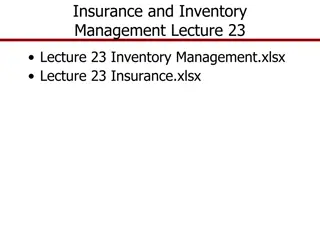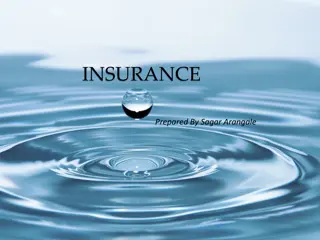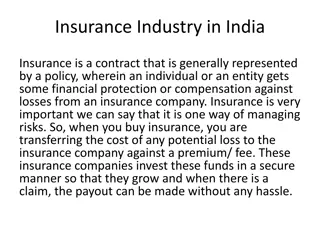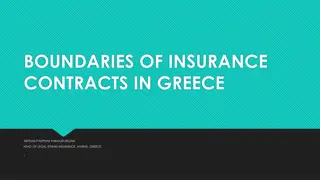Insights on Enterprise Risk Management in the Non-Life Insurance Sector
Delve into the realm of enterprise risk management within non-life insurance, focusing on emerging risks, key regulations, and risk interfaces. Explore the challenges and complexities faced by insurers, including touch points, risk interfaces with partners/vendors/intermediaries, and the evolving landscape of risk management in the global insurance industry.
Download Presentation

Please find below an Image/Link to download the presentation.
The content on the website is provided AS IS for your information and personal use only. It may not be sold, licensed, or shared on other websites without obtaining consent from the author. Download presentation by click this link. If you encounter any issues during the download, it is possible that the publisher has removed the file from their server.
E N D
Presentation Transcript
7th Seminar on Enterprise Risk Management 1st September 2023 Hotel Sea Princess, Mumbai Emerging Risk (Including Business risk in General Insurance
ENTERPRISE RISK MANAGEMENT - NON-LIFE INSURANCE A PERSPECTIVE
DISCLAIMER 3 The Document may contain Data/Information on public domain and is provided for informational purpose only. The views presented here are the sole views of the Speaker and doesn t represent the views of the Organization where he is / was working
Emerging risk management for insurers- Wills Re OECD- Emerging risks for 21 century Trends Connections and Risk-Argos WEF_The_Global_Risks_Report_2022 REFERENCES FOR THE PRESENTATION Swiss Re : World insurance: riding out the 2020 pandemic storm Coforge : Challenges Threatening - Insurance Industry in 2020 PWC-The Future of Risk Insurance Risk Function of the future Casualty Actuarial society- 11th Survey of Emerging Risks EY: 2022 Global Insurance Outlook Society of Actuaries : 10th Survey of Emerging Risks KPMG: Emerging Risks in the Global Insurance Industry
Proposition : GI Business o Business Complexity and Risk Interfaces Key Risk Indicator Approach AGENDA Emerging Risks : GI Business & Outside in View Key Regulations & Risks
GI BUSINESS PROPOSITION Touch points conundrum Sourcing/Solicitation Servicing-Claims/Policy Insurer proposition Limited Touch point with Customer- Back-end Operations Exposed to Multiple RISK Interfaces
RISK INTERFACES- PARTNERS/VENDORS/INTERMEDIARIES Health-Third Party Administrat ors Loss Policy Processing Vendors Adjusters & Salvage Software Developmen t vendors Surveyors Break in inspection vendors IT Insurance Company Infrastructur e/Hosting Insurance Intermediary Tie ups Reinsurers VAS service providers Agents / Brokers Garages & Service Providers
RISK INTERFACES Collusion with insured and incorrect inspection Under Reserve assessment Which is the Weakest Link Fraudulent issuance of policy Vulnerable infra and security ops Web services integration/ Data Exchange through emails Health-Third Party Administrators Policy Processing Vendors Technology Interfaces Customer Data Leakage from TPA Loss Adjusters & Salvage Break in inspection vendors Loss Adjusters & Salvage Policy Processing Vendors IT Infrastructure/Hosting Reinsurers Software Development vendors Health-Third Party Administrators Surveyors Business data exposed to internet Claim settlement Insurance Company IT Infrastructure/H osting Break in inspection vendors Vulnerable application Invoicing Frauds in Survey reports. Collusion with insured Frauds in policy issuance & Premium Collusion with TPA Frauds in Survey reports. Collusion with insured and claim leakages Reinsurers Insurance Intermediary Tie ups Garages & Service Software Development Providers Surveyors vendors Garages & Service Providers Agents / Brokers Surveyors Network Hospitals Agents / Brokers
Confidential EXTERNAL: BUSINESS CONTEXTUAL COMPLEXITY
Enterprise Risk Management RAG based Risk Monitoring of KRIs Underwriting Risk Market & Credit Risk Operational Risk Strategic People-Attrition Reputation Loss Ratio Investments Process Regulatory Concentration Technology Solvency/Capital Adequacy Receivables-Credit Outsourcing Reinsurance Business Continuity Plan Achievement Reserving Tax Legal & Contract Management Interest Rate Information Security Large & Cat Claims Litigation Risk Fraud Control Liquidity Product Pricing Customer Grievance Retention (customer)
KEY RISK INDICATOR APPROACH Risk Parameter Metric Red Amber Green 1.Domestic Insurers: Solvency Ratio of not less than 1.5 at the time of Placement 2.Re-Insurers: Rating of not lower than __at the time of Placement or During the course of business. Attrition %age - High performers (Employee rated 1 and 2 in performance cycle) % of Complaints resolved within T+7 days (Regulatory TAT of T+15 days) VAR > % Catastrophic Losses Financial Risk Profile of Re- Insurers and Domestic Insurers Attrition TAT for Resolution of Complaints Value at Risk (VAR) CAT Risk Outstanding Receivables (more than 1 year) as a %age of GWP Receivables Percentage (Number of critical applications not reviewed periodically as per ASLC [Application Security Life Cycle] process IT Security Management Network Uptime Uptime of critical network links Liquidity Negative Net Operating Cashflows as against investment books
Emerging risks are risks which may develop or which already exist that are difficult to quantify and may have a loss potential. Further, emerging risks are marked by a high degree of uncertainty; even basic information, which would help adequately assess the frequency and severity of a given risk, is often lacking. EMERGING RISK Consideration of Emerging Risks is important. It is a real risk management discipline Not just staring out the window
EMERGING RISK
SNAPSHOT INDUSTRY VIEW S No Risk Category Opportunities & Risk Risk Velocity 1 People Risk Automation of business processes and MIS reporting in Business Operations leading to improvement in productivity and leading to redundant roles in Branch operations High Velocity 2 External-Market Increase in quasi-insurance propositions by OEM or E commerce players. Insurance protection being sold without giving garb of insurance, affecting the insurance penetration. Medium Velocity DPDP is introducing substantial changes to data protection law and has a big impact on corporates. One of the greatest challenges for organisation is how it maps its technical approach, current technology landscape and capabilities to fulfilling its obligations under PDP. High Velocity 3 Strategic Impact of climate change on incidence of CAT events. Increased NIC for commercial lines and motor High Velocity 4 Underwriting
SNAPSHOT INDUSTRY VIEW S No Risk Category Opportunities & Risk Risk Velocity 5 Regulatory Potential change in regulations wherein license to distribute Health insurance could be provided for life insurance companies High Velocity De-tariffing of Motor Third Party (TP) rates Low Velocity 6 Regulatory Inability to be a first mover with the digital transformation strategy to gain competitive advantage in distribution, claims and underwriting. Significant increase in share of digital channel. Risk from new digital focused competitors including insurers and aggregators High Velocity 7 Strategic 8 External Market Potential risk of reinsurers not extending reinsurance support for the most carbon-intensive companies. This is the direction reinsurers are adopting to manage carbon-related sustainability risks. In the years to come reinsurers would NOT support arrangements for corporations who progressively and demonstrate structured shift away from fossil fuels. Medium Velocity
SNAPSHOT INDUSTRY VIEW CONT S No Risk Category Opportunities & Risk Risk Velocity Businesses are facing increasing pressure from society to become purpose-led, delivering value for a broader range of stakeholders, not just their investors. Investors have radically reassessed the importance and value of ESG to their business and investment strategies. There is an increasing scrutiny from regulators and heightened ESG disclosure requirements worldwide Medium Velocity 9 Strategic The risk of cyber-crime is relevant to all businesses. The focus for insurers is to understand how cyber-risks can lead to losses to their operations. High Velocity 10 Strategic
RISKS ARISING FROM REGULATORY CHANGES Description EOM and Commission Regulations Old Regulation Old regulation specifies maximum commission payable and maximum allowable expense by line of business/segmental basis New Regulation IRDAI rolled out the new Expense of Management (EOM) Regulations , 2023 on 26th March 23 The regulation stipulates that Insurance Companies need to limit their expenses (Commission + Expenses) to 30% of GWP with additional allowances for certain expenses Single Company level EOM limit without sub limits for commissions and LOB s Risk Mitigated Significant simplification/easier compliance and flexibility for companies to manage their business Risk resulting from tax issues mitigated Potential Risk Emerged Risk of increase in commission costs for certain channels Others Forms of Capital Description Sub-debt allowed up to 25% of Invested Share Capital Old Regulation New Regulation Sub-debt to be allowed up to 50% of Invested Share Capital from 25% currently No regulatory approval required for sub-debt issuance if solvency >1.8x Opportunity to optimize RoE through more efficient capital structure Risk Mitigated Potential Risk Emerged Investment in sub-debt of other insurers to be disallowed for solvency will shut-off incremental investments in such debt and reduce the universe of potential investors for our sub-debt
RISKS ARISING FROM REGULATORY CHANGES Corporate Agency Description Old Regulation Corporate agents (including banks) are currently able to tie-up with up to 3 insurers each in the General, Life, and Health insurance sectors New Regulation Corporate agents (including banks) to be able to tie-up with up to 9 insurers each in the General, Life, and Health insurance sectors for each segment Risk Mitigated It will boost insurance penetration towards the regulator's motto of 100% insurance penetration by 2047. It will allow customers to have a wider choice of insurers and products. Expected to increase competitive intensity Potential Risk Emerged Description Composite License (proposed) Old Regulation Life insurance players were not allowed to operate in non-life insurance space and vice-versa Existing regulations allow life insurance companies to offer health benefit/lumpsum schemes but not indemnity products. New Regulation Proposal to allow composite licenses ( GI+ LI+ Health) to Insurers by change in Insurance Act Risk Mitigated It will help companies achieve synergies of distribution, cost and capital. It will enable companies to sell combi-products enabling them to meet specific customer needs through product innovation. Potential Risk Emerged Certain segments of business for e.g. Retail Health may face increased competition Underwriting, products and operations are significantly different for GI & LI; running these contrasting businesses in a single company will be operationally challenging No successful global examples
RISKS ARISING FROM REGULATORY CHANGES Ind AS 17 Description Old Regulation Current accounting as per IGAAP New Regulation IFRS 17 implemented globally from 1st Jan 23 IRDAI likely to implement for Indian insurers over the next couple of years Panel of Insurance companies selected to implement it from FY 25 onwards Risk Mitigated Will bring reporting norms for Indian players in line with global peers True picture of profitability as the accounting norms takes into account discounting of liabilities and amortization of cost Potential Risk Emerged Complexity in understanding the numbers vs peers Computation complexity Investments in IT system, accounting systems to cater to IFRS requirements
THANK YOU Sumedh Jog CFO, Tata AIG General Insurance Company Satyanandan Atyam CRO, Tata AIG General Insurance Company























